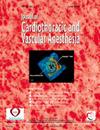心脏手术和术后患者预后的多模式脑监测。
IF 2.3
4区 医学
Q2 ANESTHESIOLOGY
Journal of cardiothoracic and vascular anesthesia
Pub Date : 2025-02-27
DOI:10.1053/j.jvca.2025.02.046
引用次数: 0
摘要
目的描述脑血流饱和度下降(≥10%)或设计:回顾性单中心队列研究:地点:大学附属心脏病中心:干预措施:无:测量和主要结果根据 rSO₂饱和度和 PSI 将患者分为 4 种大脑状态:心脏手术期间的多模式神经监测发现了高风险患者,尤其是那些同时存在饱和度降低和爆发抑制的患者,他们的预后明显较差。对这些患者进行有针对性的干预可以改善预后。未来的研究应探讨针对这一高风险群体的最佳管理策略。本文章由计算机程序翻译,如有差异,请以英文原文为准。
Multimodal Brain Monitoring in Cardiac Surgery and Postoperative Patient Outcomes
Objective
To describe the occurrence of cerebral desaturation (≥10% decrease or <50% in regional cerebral oxygen saturation [rSO₂]), deep anesthetic states (processed electroencephalography patient state index [PSI] <25), and cerebral emboli load (high-intensity transient signals [HITS]) using multimodal neuromonitoring.
Design
Retrospective single-center cohort study.
Setting
University-affiliated cardiology center.
Participants
374 adult patients undergoing cardiac surgery with cardiopulmonary bypass (CPB).
Intervention
None.
Measurements and Main Results
Patients were categorized into 4 cerebral states based on rSO₂ desaturation and PSI <25. In a subsample of 175 patients with transcranial Doppler (TCD) monitoring, patients were further classified into 8 groups based on desaturation, PSI <25, and HITS severity. Logistic regression and analysis of variance were used to examine associations between cerebral states and outcomes, including CPB separation, duration of ventilation, length of intensive care unit (ICU)/hospital stay, and mortality. Patients with desaturation and PSI <25 (state 4) had a higher EuroSCORE II, more comorbidities, longer CPB/aortic clamping times, and worse postoperative outcomes, including extended ICU and hospital stays. Within the TCD subsample, those with moderate-to-severe HITS alongside desaturation and PSI <25 experienced the poorest outcomes, such as prolonged hospitalization and difficult CPB separation. Multivariable models confirmed associations with adverse outcomes, although some effects were attenuated after adjustment.
Conclusions
Multimodal neuromonitoring during cardiac surgery identified high-risk patients, particularly those with concurrent desaturation and burst suppression, who had significantly worse outcomes. Targeted interventions for these patients could improve outcomes. Future studies should investigate optimal management strategies for this high-risk group.
求助全文
通过发布文献求助,成功后即可免费获取论文全文。
去求助
来源期刊
CiteScore
4.80
自引率
17.90%
发文量
606
审稿时长
37 days
期刊介绍:
The Journal of Cardiothoracic and Vascular Anesthesia is primarily aimed at anesthesiologists who deal with patients undergoing cardiac, thoracic or vascular surgical procedures. JCVA features a multidisciplinary approach, with contributions from cardiac, vascular and thoracic surgeons, cardiologists, and other related specialists. Emphasis is placed on rapid publication of clinically relevant material.

 求助内容:
求助内容: 应助结果提醒方式:
应助结果提醒方式:


